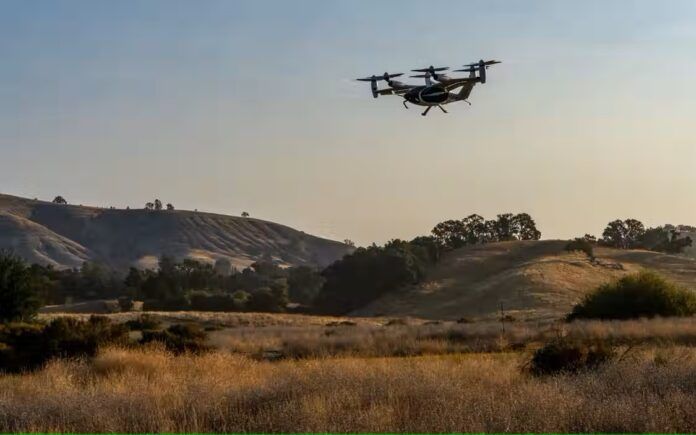Joby Aviation reported on Tuesday that its prototype electric vertical takeoff and landing (eVTOL) aircraft met the company’s noise profile goals during acoustic testing completed with NASA last fall. The tests, which took place at Joby’s facility near Big Sur, California, were conducted over two weeks in September 2021 as part of as part of NASA’s Advanced Air Mobility (AAM) National Campaign. Results showed that Joby’s aircraft registered the equivalent of 45.2 A-weighted decibels (dBA) from an altitude of 1,640 feet (500 meters) at 100 knots airspeed. In addition, the eVTOL’s acoustic profile during planned takeoff and landing profiles was measured to be below 65 dBA at a distance of 330 feet (100 meters) from the flight path.
“We will use this data to help us understand the vehicle’s performance characteristics, the acoustics profiles, as well as information that will help us develop modeling scenarios,” said Shivanjli Sharma, acting lead for the NASA AAM National Campaign. “Not just one or two flights per day, but at the scale that we predict these vehicles will begin flying when used by the public.”
Data was collected using NASA’s Mobile Acoustics Facility and an array of more than 50 pressure ground-plate microphones. NASA and Joby both plan to present technical papers on the testing procedures and measurements at industry conferences this summer. Designed as an air taxi, Joby’s five-seat, piloted eVTOL will reportedly travel at speeds of up to 200 MPH and have a maximum single-charge range of 150 miles. The company says it is targeting 2024 for the launch of its aerial ridesharing service, although it is not yet known how the FAA’s recent change in its approach to eVTOL certification and the crash of an uncrewed prototype during flight testing last February might affect that timeline.




































Man. Hate to start this with pessimism. For noise to be tested a neutral third party should be brought in early.
And regardless of noise profiles, noise is noise. And when people complain about aircraft noise it’s usually about ongoing noise. Ie the length of operations from morning to night. Also what time should flights be allowed? After midnight? Four am? So what I fear here is that the noise testing will set an arbitrary level that the company can say they’re operating within limits thus clearing them from restrictions. I hope I’m wrong but I predict in major cities a small percentage of the population will live with very annoying noise issues and with no power to change anything. Add to that all the package delivery drones and that won’t be a great out one in terms of real noise pollution.
The test was conducted by NASA – check out the first linked article. Their intent was to collect data, not to advance (or to retard) the eVTOL business. I accept them as a neutral, third party.
I’m still not convinced there actually is a valid business case for “VTOLs everywhere”, so maybe noise worries will prove to be a non-issue.
Another aspect to this is (very) subjective: What is the sound of the noise like? Car companies spend a lot of money tuning the sound of exhaust on sports car to sound “right.”
(Not to condone wikipedia. But at this time, this entry seems valid: en.wikipedia.org/wiki/Psychoacoustics )
45 dBA isn’t very loud. But if it sounds like nails on a chalkboard, then it ain’t gonna fly. (Pun intended.)
A low rumble is easier on the human ear than a high whine. And does the noise dither? Constantly changing noise that sound like bees nearby (drones at my local park) get my attention more than a gas powered generator.
I don’t know if there’s a psychoacoustic standard for what is considered “acceptable” noise.
Did it pass the noise test when it crashed and was destroyed?
What kind of a metric is 100 meters? These things are supposed to be “urban mobility”. 100 meters is not urban. Applying the inverse square law, that 65db figure at 100 meters becomes 79db at 20 meters.
Hummmm,
Here we have two current articles on AvWeb, at the core discussing rules.
Here’s a comment on the Red Bull article:
“Whether the rules are “right” or not is irrelevant–they exist and we’re bound by them.”
These drone operators, like it or not, are following the rules. Whether the rules are “right” or not is irrelevant-they exist and we’re bound by them.
How is it that with one article, rules are to be followed without question, and in this article, proper operation and following the rules is frowned upon?
My apologies, I posted under the wrong article.